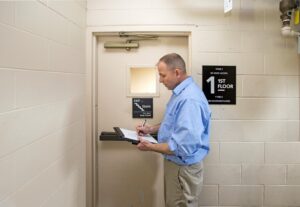Banks are not just financial institutions; they are also custodians of security and safety for their customers and employees. Ensuring a secure environment within a bank premises goes beyond protecting assets; it also involves safeguarding lives in case of emergencies such as fires. One crucial aspect of fire safety in banks is the regular inspection of fire doors. These inspections are not only necessary for compliance with regulations but also vital for maintaining the integrity of the fire protection system. In this comprehensive guide, we delve into the importance of fire door inspections in banking institutions, highlighting when and why they are necessary.
Understanding Fire Doors
Before delving into the specifics of fire door inspections, it’s essential to understand what constitutes a fire door and its significance in building safety. Fire doors are specially designed doors that act as a barrier against the spread of fire and smoke within a building. They are a critical component of passive fire protection systems, helping to compartmentalize fire and prevent its rapid spread, thereby allowing occupants to evacuate safely and minimizing property damage.
Regulatory Requirements
Banks, like other commercial buildings, are subject to strict fire safety regulations imposed by local building codes and authorities. These regulations often mandate the installation of fire doors in specific locations throughout the building, including stairwells, corridors, and areas containing electrical or mechanical equipment. Additionally, they typically require regular inspections and maintenance of fire doors to ensure their effectiveness in the event of a fire.
Frequency of Inspections
Fire door inspections are not a one-time affair; they require regular assessments to ensure compliance and functionality. The frequency of inspections may vary depending on various factors such as building usage, occupancy load, and local regulations. However, as a general guideline, fire door inspections in banking institutions should be conducted at least annually, if not more frequently.
Importance of Inspections
Regular inspections of fire doors are crucial for several reasons:
Ensuring Compliance: Compliance with fire safety regulations is paramount for banking institutions to avoid penalties and legal liabilities. Routine inspections help identify any non-compliance issues and address them promptly.
Maintaining Functionality: Over time, fire doors may experience wear and tear due to usage, environmental factors, or improper maintenance. Inspections help identify any defects or malfunctions that could compromise the door’s ability to contain fire and smoke effectively.
Preserving Occupant Safety: The primary purpose of fire doors is to protect occupants by slowing down the spread of fire and smoke, allowing them more time to evacuate safely. Regular inspections help ensure that fire doors remain in optimal condition to fulfill this critical function during emergencies.
Minimizing Property Damage: In the event of a fire, properly functioning fire doors can help contain the blaze to its area of origin, limiting property damage and potentially saving millions of dollars in restoration costs for banking institutions.
Inspection Process
Fire door inspections involve a thorough assessment of various components to ensure their proper operation and compliance with regulations. The inspection process typically includes:
Visual Inspection: Inspectors visually examine the door, frame, hinges, and hardware for signs of damage, wear, or improper installation.
Operational Testing: Inspectors test the door’s operation, including its ability to close fully and latch securely. They also check the integrity of seals and gaskets to prevent the passage of smoke.
Verification of Labels and Certification: Inspectors verify that fire doors are appropriately labeled and certified according to relevant standards and regulations.
Documentation: Detailed documentation of inspection findings, including any deficiencies or corrective actions required, is essential for compliance and record-keeping purposes.
Addressing Deficiencies
If any deficiencies are identified during the inspection, prompt corrective action is necessary to ensure the continued effectiveness of fire doors. Depending on the nature and severity of the deficiencies, corrective measures may include repairs, adjustments, or replacement of components.
Conclusion
In conclusion, a fire door inspection is a critical aspect of fire safety in banking institutions, ensuring compliance with regulations and maintaining the integrity of passive fire protection systems. By conducting regular inspections and addressing any deficiencies promptly, banks can enhance occupant safety, minimize property damage, and demonstrate their commitment to maintaining a secure environment for customers and employees alike. Investing in fire door inspections is not just a legal requirement but also a proactive measure to safeguard lives and assets in the event of a fire emergency.


